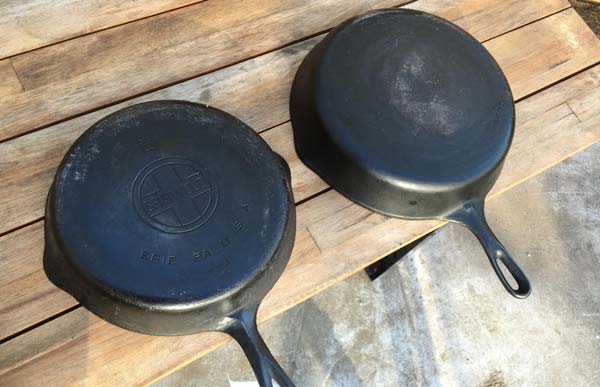If you are a fan of vintage cookware, the name of Wagner and Griswold should not be new to you. When it comes to cast iron cooking utensils, these two brands used to be the king. Sadly, their day is long behind us.
But still, there are a lot of collectors out there who are constantly on the lookout for these appliances. Despite their age, a lot of their cookware is still in circulation.
Sometimes they pop up here and there and collectors snatch them up any chance they get. This is quite understandable though because when it comes to cooking performance, they still manage to hold up quite well.
But if one were to put them up against each other, would one come out above the other?
Well, that is a matter of some debate. These two brands are like choosing between Coke and Pepsi.
They have their own fanbase, and it mostly depends on the personal preference of the user. In this article, we will take a walk down history lane and look at the two brands.
Maybe after looking at the brands, you will have an easier time choosing between Wagner vs. Griswold cast iron if you ever get the chance. So, hop on, and let us get started.
In 1957 Randall’s Wagner division acquired Griswold Manufacturing from McGraw-Edison. In 1959 Randall was itself acquired by Textron. Textron sold the Wagner and Griswold lines to General Housewares Corporation (GHC) in 1969. In 1996 GHC sold rights to the Wagner and Griswold lines to Slyman Group.

About Wagner Manufacturing Company
The journey of Wagner Manufacturing Company started in the year 1891 with the hands of two brothers, Milton M. Wagner, and Bernard P. Wagner. Based in Sidney, Ohio, this company dealt almost exclusively in producing cast iron cookware.
However, later on, they expanded towards nickel-plated and aluminum products also. In the year 1897, the company further expanded their business by buying another company named Sidney Hollow Ware.
William H. Wagner, another brother of the two founders hopped on to manage the expanding business. However, after six years, they resold Hollow Ware to Philip Smith, the original owner.
The company started selling to the global market by the year 1913. In in 1934, they brough Mangalide cast aluminum cookware, the first of its kind, to the market.
However, during the great depression, the company started struggling financially. Around 1946, they started to consider selling it.
Finally in the year 1953, Wagner Manufacturing Company was finally sold to Randall Company.
About Griswold Manufacturing Company
The initial conception of the Griswold Manufacturing Company was in Erie, Pennsylvania. It was originally a joint venture between Matthew Griswold and two of his cousins, Samuel and J.C Seldon.
At the start, they mostly dealt with hardware, However, the company shifted to cast iron cookware by expanding their operations in the year 1870.
Even at that time, it was not called Griswold Manufacturing Company. Rather they carried out their operations under the name Seldon-Griswold Manufacturing Company.
Around the later part of the 1880s, Matthew Griswold officially changed the name to Griswold Manufacturing Company. This became possible because he bought a stake in the firm from his cousins in the year 1884.
After that, Griswold became a family-run business, with Matthew’s son taking over the ownership in 1905. 9 years later in 1914, the business passed over to Marvin Griswold.
He was the one who is responsible for turning the local brand into an international brand by selling products all over the world.
Around 1940 however, the quality of their products started to see a steep decline. Unable to maintain the same level of quality, the Griswold family decided to sell the company. In 1946, they finally managed to sell it to Wagner Manufacturing Company.
During its lifespan, the company produced many excellent cookware and had gathered mass popularity. The Erie Factory where it all began finally closed down in 1957.
Collecting 101: Cast Iron Cookware! Griswold Wagner History Popularity & Value! Episode 3
FAQ
Who owns Wagner cast iron?
Who bought Wagner?
When did Wagner go out of business?
Is Wagner cast iron valuable?
Are Wagner & Griswold a good brand?
If you are a fan of vintage cookware, the name of Wagner and Griswold should not be new to you. When it comes to cast iron cooking utensils, these two brands used to be the king. Sadly, their day is long behind us. But still, there are a lot of collectors out there who are constantly on the lookout for these appliances.
Is Griswold cast iron better than Wagner?
When it comes to quality, performance, or durability, the quality of both Wagner and Griswold cast iron are quite similar. So, if you are someone who likes to collect and dabble with antique cookware, both of these brands can be a great choice. Putting Wagner Vs.
Who bought Griswold Manufacturing?
1957, Griswold Manufacturing was sold to the McGraw Edison Company in Illinois. The company quickly off-loaded Griswold to the Wagner Manufacturing Company. Textron Inc. of Rhode Island buys Wagner Manufacturing.
Are Wagner and Griswold cookware good?
Both Wagner and Griswold cookware were made with extreme care and precision. Because of this, they are built stronger and sturdier than most other cast iron utensils that you can find these days. If durability is important to you, this is as good as it gets.
